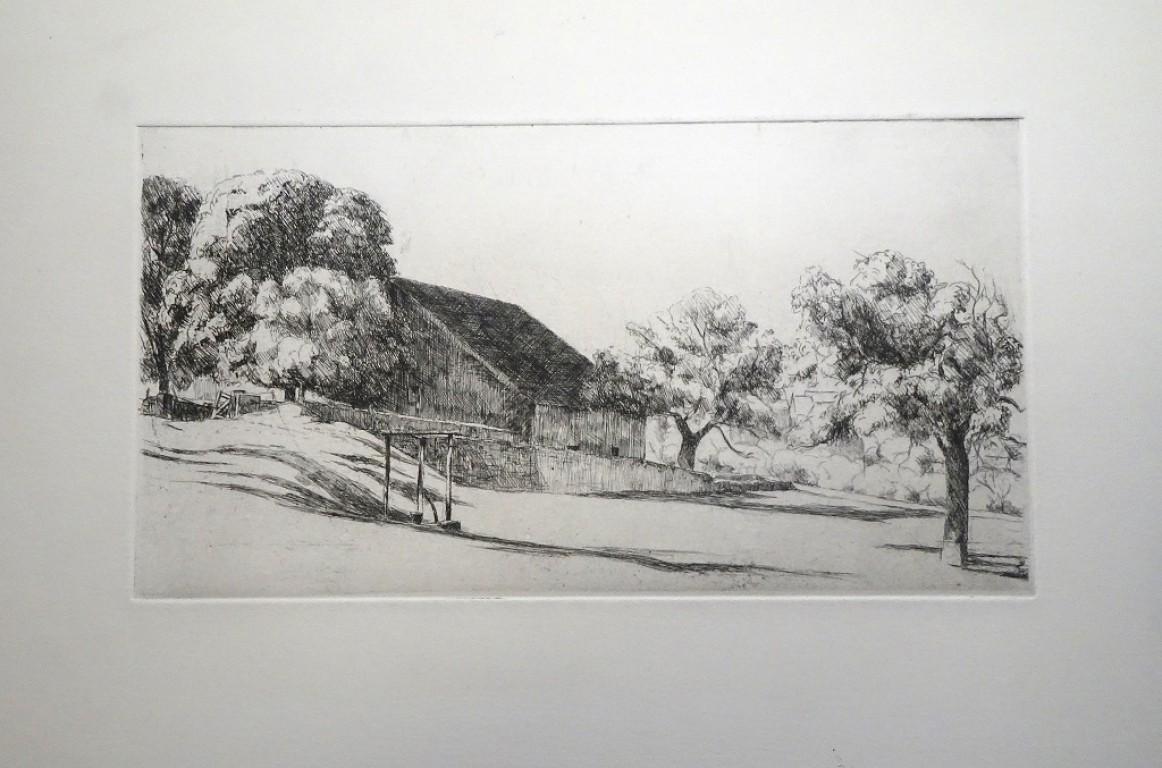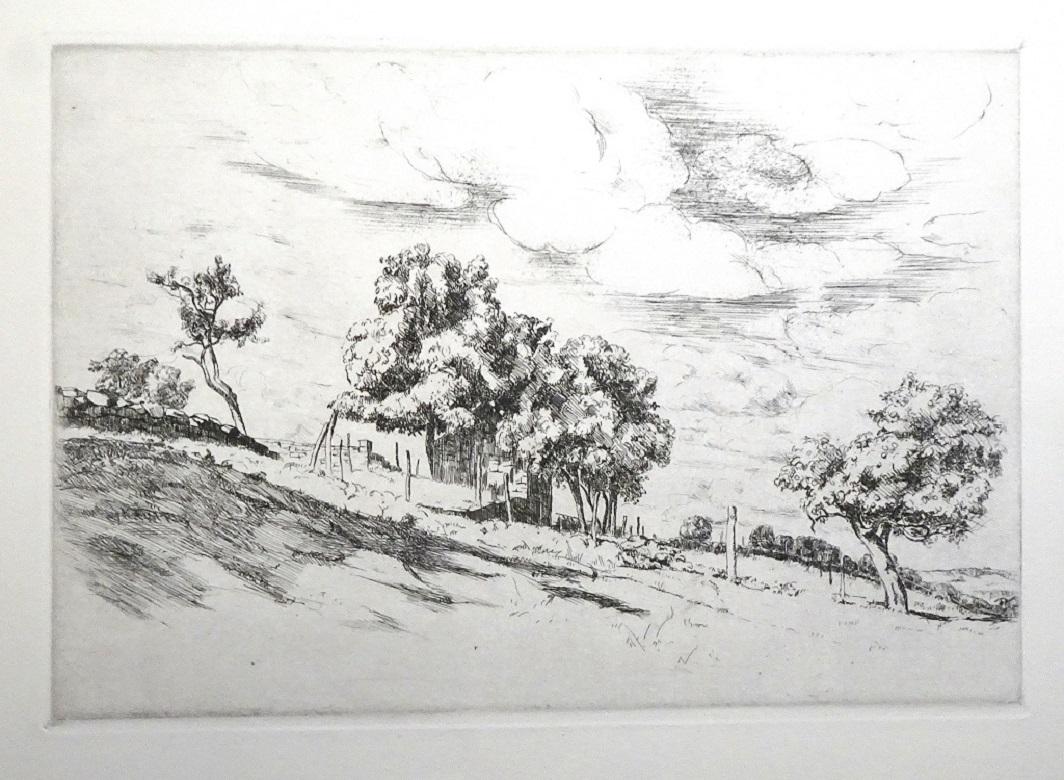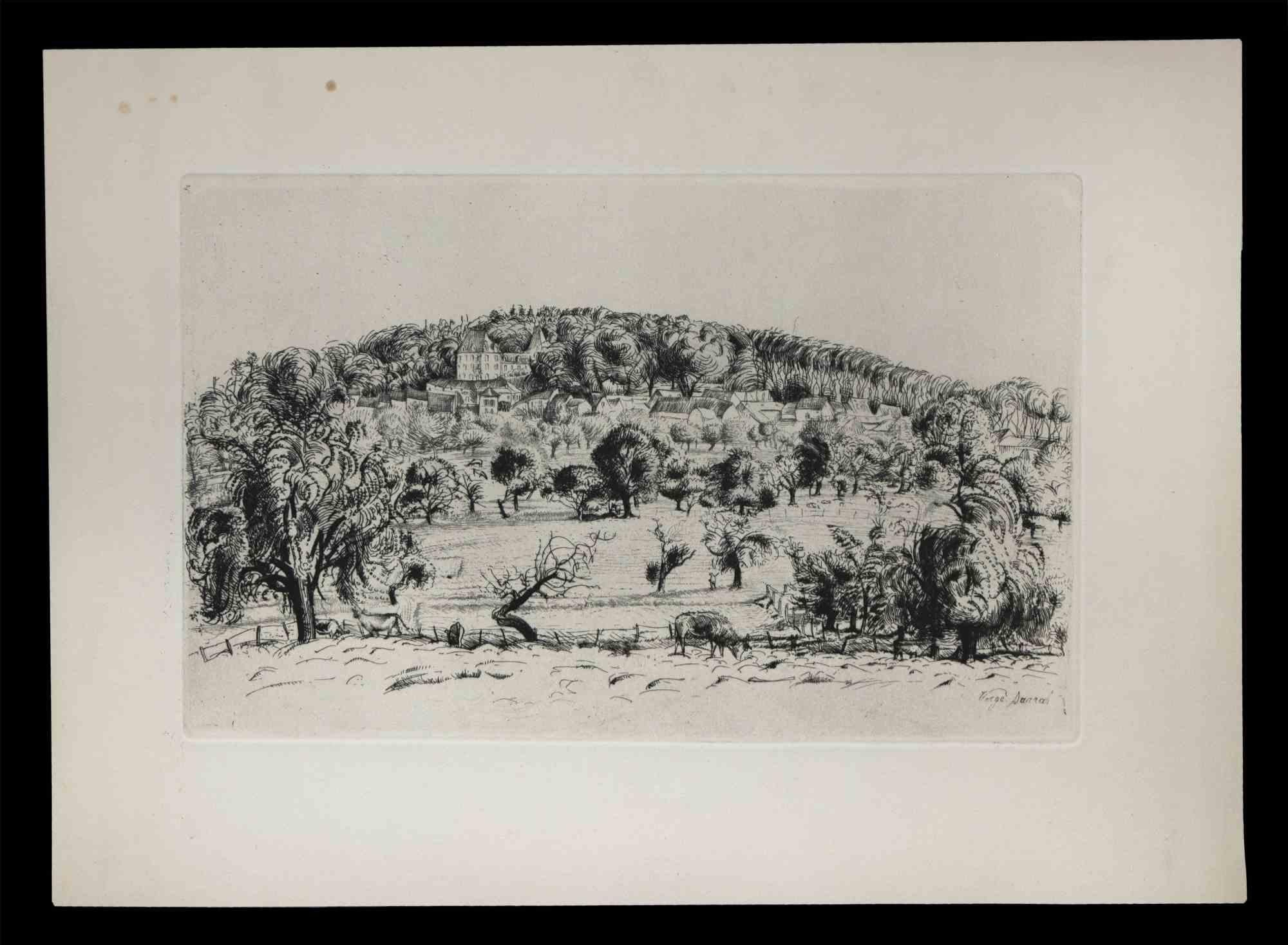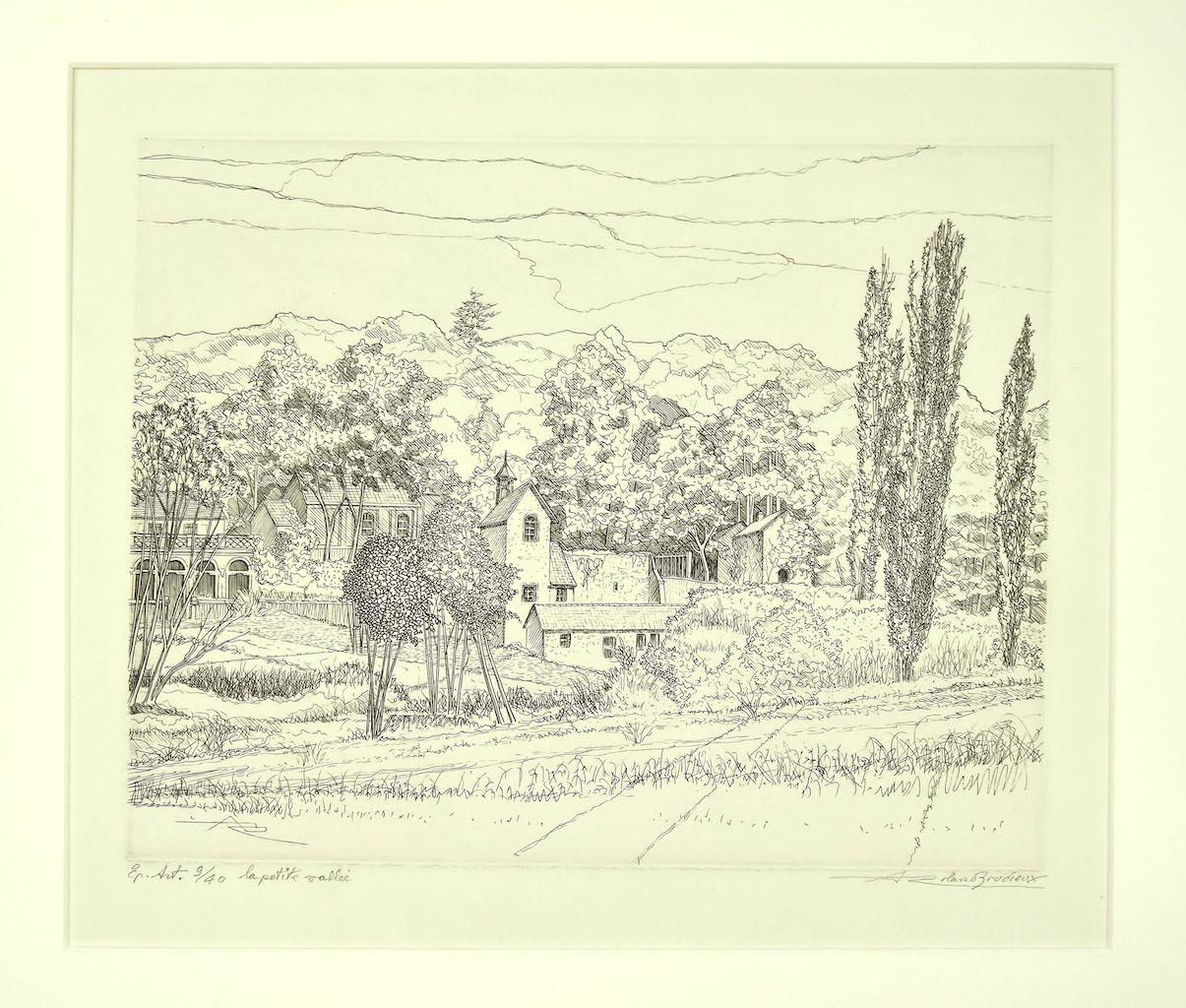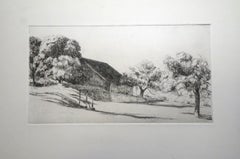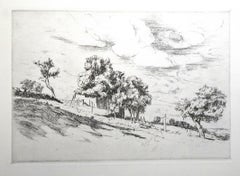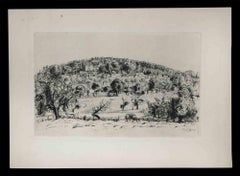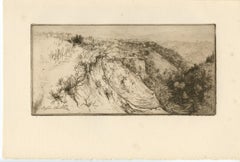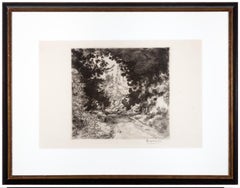Items Similar to French Landscape - Original Etching by E. Corneau - 1930s
Want more images or videos?
Request additional images or videos from the seller
1 of 5
Eugene CorneauFrench Landscape - Original Etching by E. Corneau - 1930s1930s
1930s
$215.40
£160.88
€180
CA$296.75
A$323.40
CHF 171.26
MX$3,884.40
NOK 2,168.13
SEK 1,993.38
DKK 1,371.29
About the Item
French Landscape is an original artwork realized by Eugène Corneau during the 1930s.
Etching and drypoint on paper.
Very good conditions except for some small folds on the left margin.
Precious and elegant artwork realized with a combination of drypoint and etching on paper; the engraving represents a view of a beautiful French landscape with trees and a building in the center of the composition.
Eugène Corneau (Vouzeron, 1894 – Pontaubert, 1976) was a French painter, artist, and engraver. From 1901, he lived in Paris, and he regularly exhibited at the Salon d’Automne, where, in 1953, he became one of its members. From 1923, he also exhibited at the Salon des Tuileries. In 1925, he obtained a scholarship and, from 1925 to 1926, he studied at Algeri and travelled along North Africa. When he went back to France, he moved to Pontaubert, where he lived until his death. From 1941 to 1944, he travelled along Berry in France. He exhibited for the first time in 1918 in Paris. He decorated the Berry-Nivernais Pavilion for the Universal Exposition. In 1940, he exhibited at the Venice Biennal; he exhibited also in Bruxelles (1925, 1928), in Alger (1927), New York (1928, 1938), Harleem (1931) and Tunis (1943). An important retrospective on his work took place in 1975 in Saint-Jean-de-Monts (Vandée). From 1953 to 1962, he taught engraving art at the National School of Fine Arts of Algeri and became the vice-president of the Society of French Painters and Engravers. He illustrated several artworks, such as Le songe de Vaux by La Fontaine and Typhon by Conrad. In his life, he realized several artworks representing Breton and Provençal landscapes, old streets of French villages, and harbours of the Atlantic Ocean.
- Creator:Eugene Corneau (1894 - 1976)
- Creation Year:1930s
- Dimensions:Height: 12.8 in (32.5 cm)Width: 19.69 in (50 cm)Depth: 0.04 in (1 mm)
- Medium:
- Movement & Style:
- Period:
- Framing:Framing Options Available
- Condition:Insurance may be requested by customers as additional service, contact us for more information.
- Gallery Location:Roma, IT
- Reference Number:Seller: M-9677101stDibs: LU65034166341
About the Seller
4.9
Platinum Seller
Premium sellers with a 4.7+ rating and 24-hour response times
1stDibs seller since 2017
7,851 sales on 1stDibs
Typical response time: 1 hour
- ShippingRetrieving quote...Shipping from: Monaco, Monaco
- Return Policy
More From This Seller
View AllFrench Landscape - Etching by Eugene Corneau - Mid-20th Century
By Eugene Corneau
Located in Roma, IT
French Landscape is an artwork realized by Eugène Corneau during the 1930s. Etching and drypoint on paper.
Very good conditions except for some small folds on the left margin.
Preci...
Category
Mid-20th Century Modern Landscape Prints
Materials
Etching
French Village - Original Etching and Drypoint by Eugène Corneau - 1930s
By Eugene Corneau
Located in Roma, IT
French Village is an original artwork realized by Eugène Corneau between the end of the 1920s and the beginning of the 1930s.
The monogram of the artist is present on the lower left...
Category
1930s Modern Figurative Prints
Materials
Drypoint, Etching
Untitled - Original Drypoint by Eugene Corneau - XX Century
By Eugene Corneau
Located in Roma, IT
Untitled is an original artwork realized by Eugène Corneau during the 1930s.
Etching and drypoint on paper. Monogram in pencil on the lower left.
Excellent conditions.
Precious an...
Category
20th Century Modern Landscape Prints
Materials
Drypoint
French Landscape - Etching by Henry Verger-Sarrat - 20th Century
By Henry Verger-Sarrat
Located in Roma, IT
The French Landscape is an original etching realized by Henry Verger-Sarrat in the 20th Century.
Good conditions except for some foxings.
The artwork is depicted through strong str...
Category
1810s Modern Figurative Prints
Materials
Etching
Untitled - Original Etching and Drypoint by Eugène Corneau - 1930s
By Eugene Corneau
Located in Roma, IT
Untitled is an original artwork realized by Eugène Corneau in the first years of the 1930s. Etching and drypoint on paper. Monogram of the artist on the lower left. Excellent conditi...
Category
1930s Modern Figurative Prints
Materials
Drypoint, Etching
Landscape - Original Etching by Andre Roland Brudieux - 1970s
By André Roland Brudieux
Located in Roma, IT
Landscape is an original modern artwork realized by Andre Roland Brudieux.
Original etching on paper. Image Dimensions: 24 x30 cm
Hand-signed o...
Category
1970s Modern Landscape Prints
Materials
Etching
You May Also Like
"La vallee fertile, pres Monte Oliveto Maggiore" original etching
By Edgar Chahine
Located in Henderson, NV
Medium: original etching. Catalogue reference: Tabanelli 199. This impression on laid paper was printed in 1906 and published by Gazette des Beaux Arts. Plate size: 4 x 8 1/2 inches ...
Category
Early 1900s Landscape Prints
Materials
Etching
A Signed Etching of a Pastoral Scene in Picardy, France by Paul Emile Lecomte
By Paul Emile Lecomte
Located in Alamo, CA
A beautiful aquatint etching of a serene pastoral scene in the Picardy region of northern France by Paul Emile Lecomte (1877-1950). A mother and child are seen walking down a path in...
Category
Early 20th Century Impressionist Landscape Prints
Materials
Aquatint
"Ferme a Vauhalan" original etching
Located in Henderson, NV
Medium: original etching. Published in 1912 by Gazette des Beaux Arts. Plate size: 5 x 9 1/4 inches (128 x 232 mm) on cream laid paper. Signed in the plate, not by hand.
The Gazett...
Category
1910s Landscape Prints
Materials
Etching
"Road Landscape, " Original Etching and Aquatinit
By Félix Bracquemond
Located in Milwaukee, WI
"Road Landscape" is an original etching and aquatint by Felix Bracquemond. This piece depicts a shadowy path through the foliage. The artist signed the piece in the lower right and i...
Category
1870s Impressionist Landscape Prints
Materials
Etching, Aquatint
"Environs de Rix" original etching
By Adolphe APPIAN
Located in Henderson, NV
Medium: original etching. This impression on laid paper printed in 1868 for Philip Gilbert Hamerton's very scarce "Etching and Etchers". Plate size: 3 1/2 x 6 7/8 inches (88 x 175 mm...
Category
1860s Prints and Multiples
Materials
Etching
Vintage Landscape Etching - The Flock
By Emile Roux-Fabre
Located in Houston, TX
Vintage black and white etching of a farmer leading his flock of sheep to a pasture bordered by a small village by French artist Emile Roux Fabre, circa 1930. Signed in pencil lower ...
Category
1930s Landscape Prints
Materials
Paper, Ink
More Ways To Browse
Miami Street Art
Nebraska Artist
Painting Spanish Scene
Paintings Of Copenhagen
Paintings Of Rome Italy
Pez Art
Rally Car
Renee French
Rock N Roll Art
Textile Fiber Art Abstract
Tunisia Painting
Valley Forge
Vintage Brooklyn Sign
Watch Lot
A Chorus Line
Antique Anatomical Drawings
Antique Goddess Painting
Bacardi Vintage
